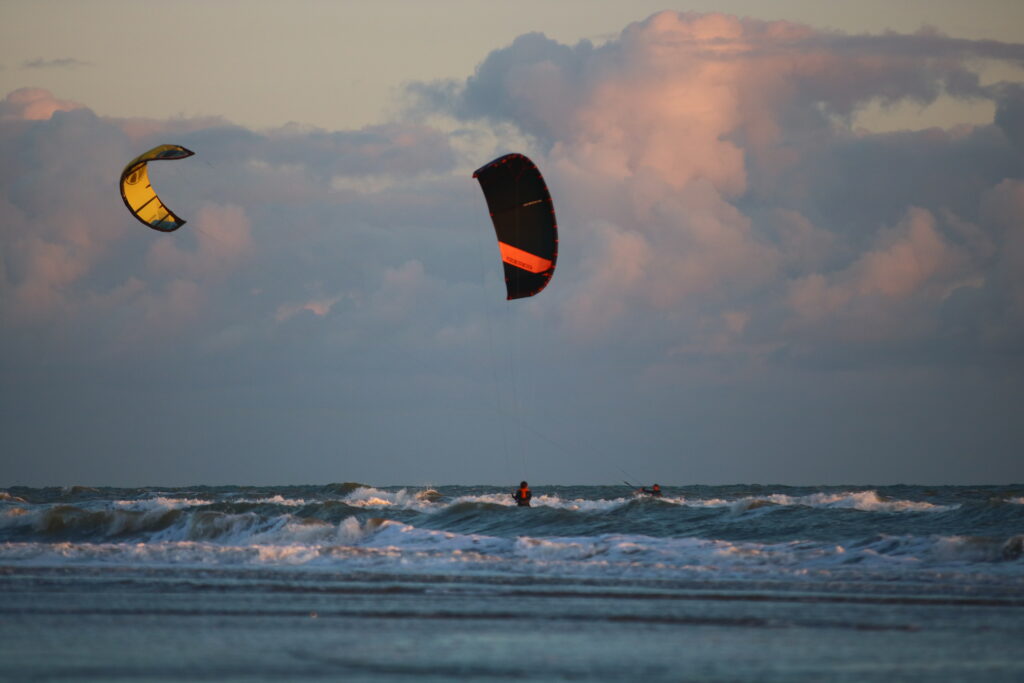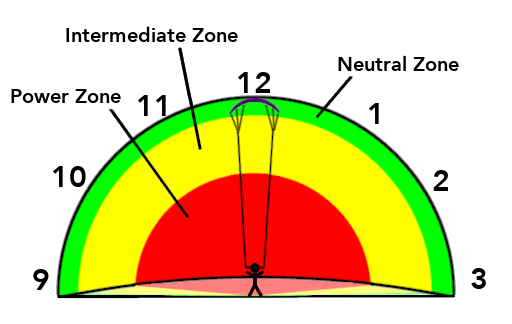In a sport like Kitesurfing, where we rely on the wind entirely to ride, leap and spin, so when we ask ‘what is the wind?’ it’s important we know the answers! The more knowledge you have, the better equipped you will be assessing wind conditions for your sessions and to speed up your learning journey so you can be a wind whisperer too.
Table of Contents

What is the wind?
Wind is the movement of air particles from one place to another, moving from an area of high pressure to an area of low pressure. It is the movement of air that enables our kite to create lift and this allows us the power to move with the kite.
As a beginner kitesurfer, you don’t need to know everything about why wind happens on a global scale, but it is important that you can recognise what it is doing where you are and how you can use it. You need to know how you use your kite to harness the wind, the best directions to kitesurf at your beach and what speeds you should kitesurf with your equipment. Further to this, you should be able to recognise changes and factors that may cause it to increase, decrease or become more turbulent as these can affect your ability to kitesurf safely.
What is the Wind Window Theory?
The radius in which the kite can fly is called the wind-window. The size of the window is determined by the length of your kite lines. You are the centre point; wherever you move while flying the kite, the window moves with you.
The wind-window is the only area that your kite will fly in, it cannot fly beyond. As you stand with your back to the wind, the window reaches crosswind and downwind of you. There are 3 zones of power; neutral, intermediate and power. The closer you fly the kite to the centre of the window, the more power you will get as the kite’s angle is more exposed to the wind.
Around the neutral zone (marked green) the kite has the least power as the surface area of the kite is not angled directly into the wind – a low angle of attack. We can move the kite gently around the neutral zone without generating power making it the safest position for launching, landing and walking.
We refer to the positions on the edge of the wind window as positions on the top half of a clock face. A kite flying directly above us is positioned at 12 o’clock. Steered gently to the left it would move through positions 11, 10 and 9 o’clock. Moved to the right the kite would pass through 1, 2 and 3 o’clock.
The intermediate zone (marked yellow) is further downwind than the neutral zone. As the kite flies through the intermediate zone it has more surface area facing the wind (an increased angle of attack) than before and now generates more lift than in the neutral zone.
Furthest downwind and most central in the window is the power zone. As the kite flies through the power zone its surface area is most exposed to the wind. It is at its highest angle of attack so it generates the most lift.
As we move the kite in and out of the power zone we generate power. You can generate this power on either the left or right side of the wind window and pull you in that direction.
To learn more about forces on the kite and how it flies, read this article (How an LEI Kitesurfing kite flies).
What speeds can I kitesurf in?
As a beginner kiter, it is important to practise within a wind range that is safe and makes it easy for you to practise your skills. Practising independently, we recommend beginners to fly their kites in 10-25mph. Most importantly, it needs to be the correct kite for the wind speed so that you don’t have too much power.
It is the size of the kite and your weight which denotes the strength of the winds you can use. As an example, a 75kg beginner will use a 12m kite in 10-18mph, 9m in 16-22 and a 7m in 22+. Use this useful equation to calculate which size kite you will use (link) based on your weight and the wind speed as you go kiting.
Whenever you go kiting, you should be aware of the forecast and any predictions for the wind to increase, decrease or change direction. If the wind is due to increase, don’t setup too large a kite and be prepared to land and downsize your kite if needed.
Read more about how to read a weather forecast (link).
In addition to the forecast, local effects such as the Seabreeze we often get at Camber Sands can increase wind speed significantly above the forecasted range. If it’s a clear sunny day, a Seabreeze can double the speed, so always bring your smaller kites with you whatever the forecast. Read more about local weather effects (link).
Recognising how windy it is is a skill that you will learn over time and one that is essential to know which kite size you should be flying. This handy wind speed chart shows the visual signs you can spot around you that will indicate roughly what the speed is. If you want to know exactly what the speed is, a wind anemometer will do the job.
The best wind directions to kitesurf?
Along with speed, we want to know what is the wind direction as this will determine which beach we should kitesurf at.
The best directions to kitesurf are when they blow onshore or cross-onshore. These are the safest directions as the wind will return you and your equipment to land. At Camber, our most common direction is a South Westerly which blows cross-onshore. Cross-onshore winds are the ideal direction as they allow the rider to move away from the beach into a safe water depth for riding easily, while also returning the rider to the beach in any event where they cannot ride upwind.
It is also possible to kite in cross-shore wind though riders should be wary of the direction moving to cross-offshore.
Avoid kiting in offshore and cross-offshore winds as even the slightest error or drop in speed, it will drift you out to sea. There are places around the world offering kitesurfing in offshore winds, though these spots tend to offer a paid rescue boat service.
Using resources like Windy or Windfinder, you can find a visual map of your spot and where the wind is blowing from – have a look at camber sands’ wind direction now here to see whether it’s on or offshore.
So Now when someone asks you ‘What is the wind?’ You can tell them all about it!
Next up: How to site assess your kite spot using SHOE

